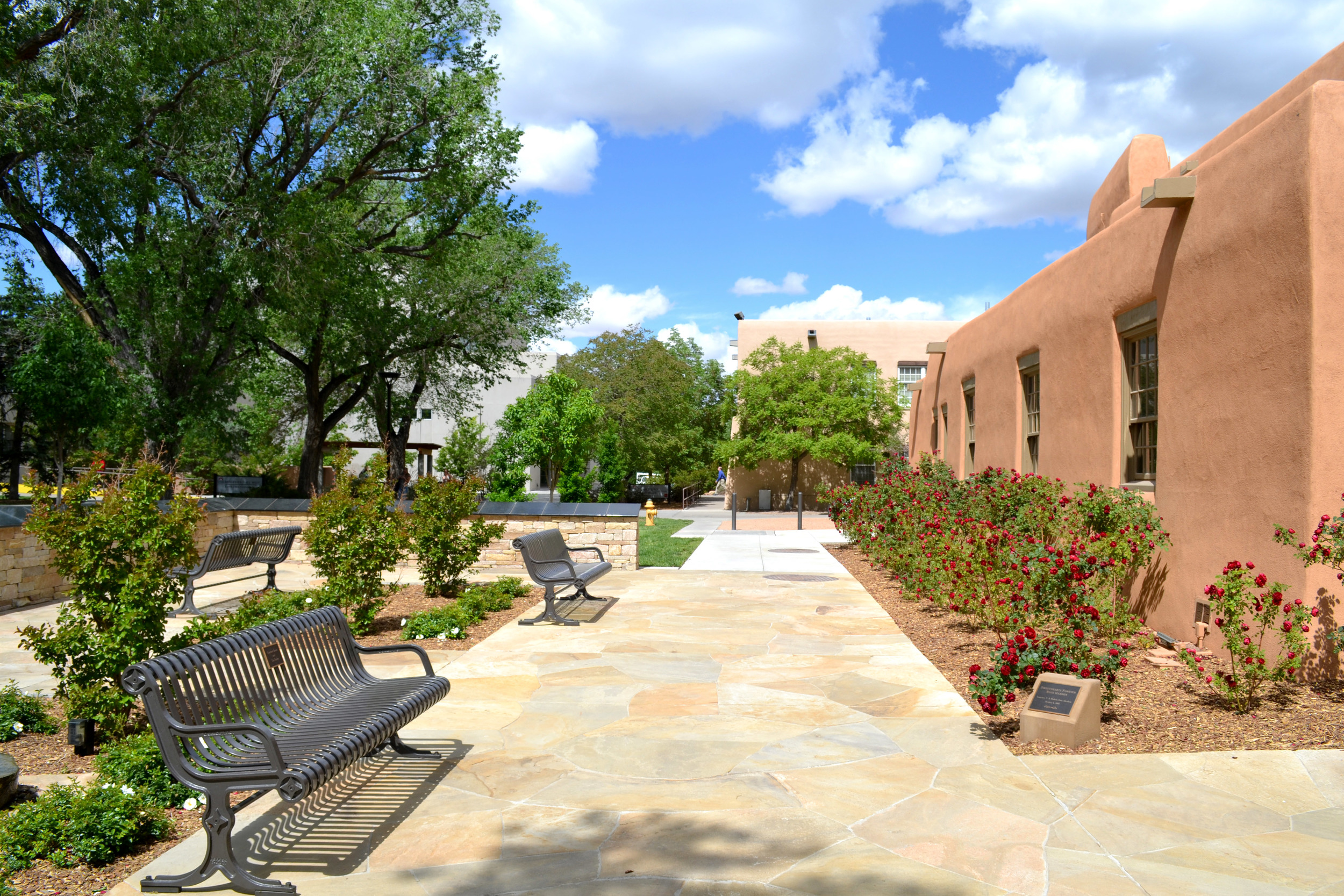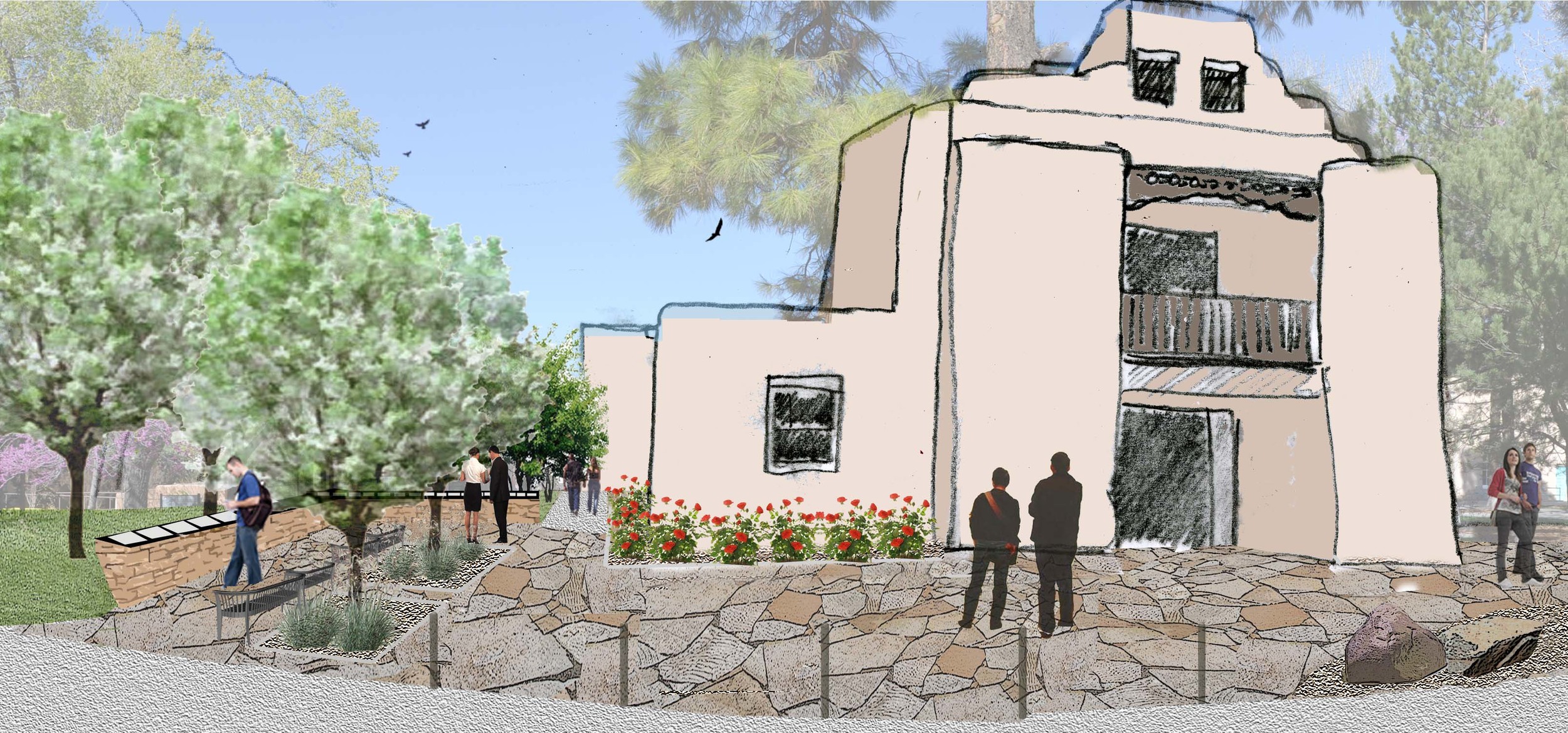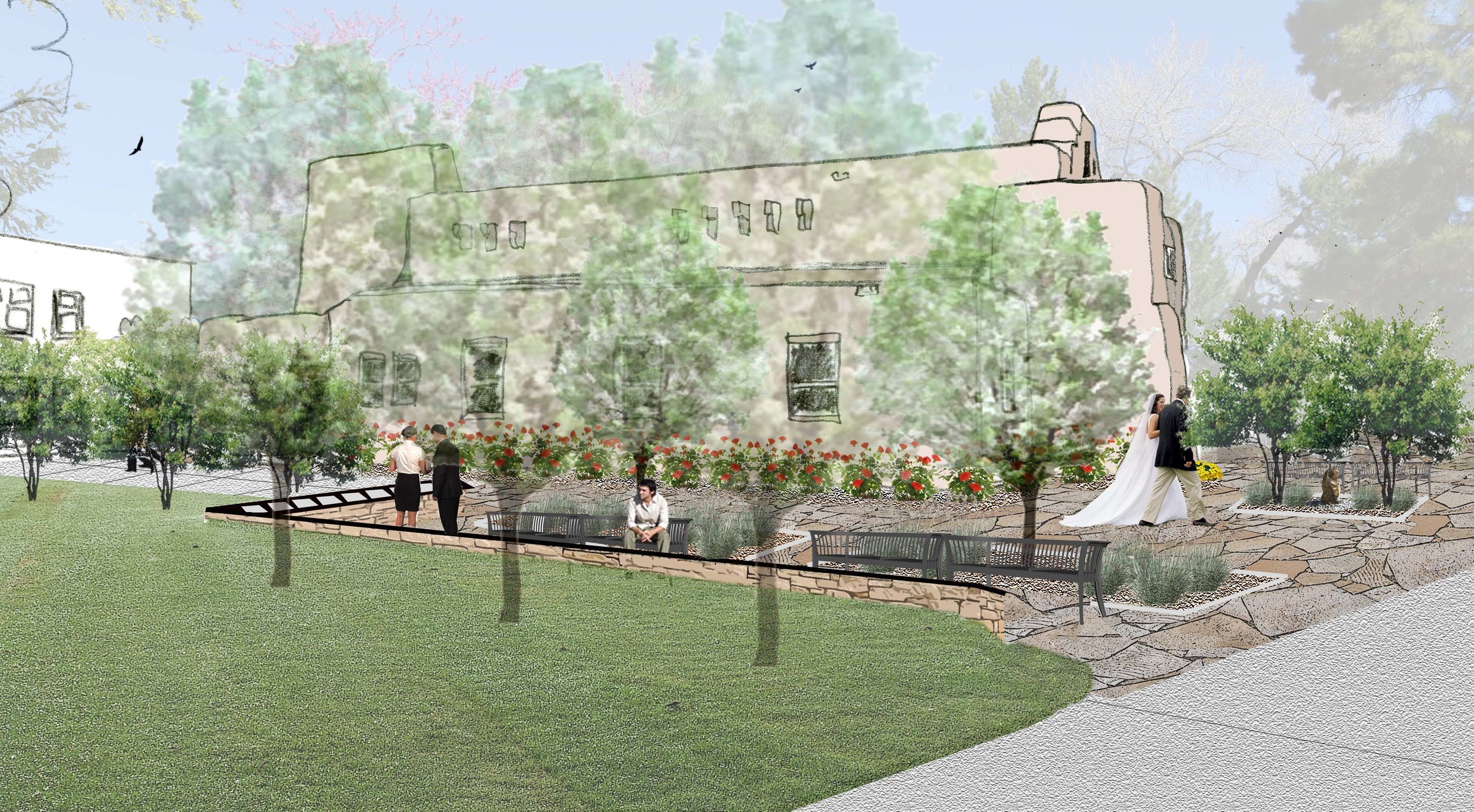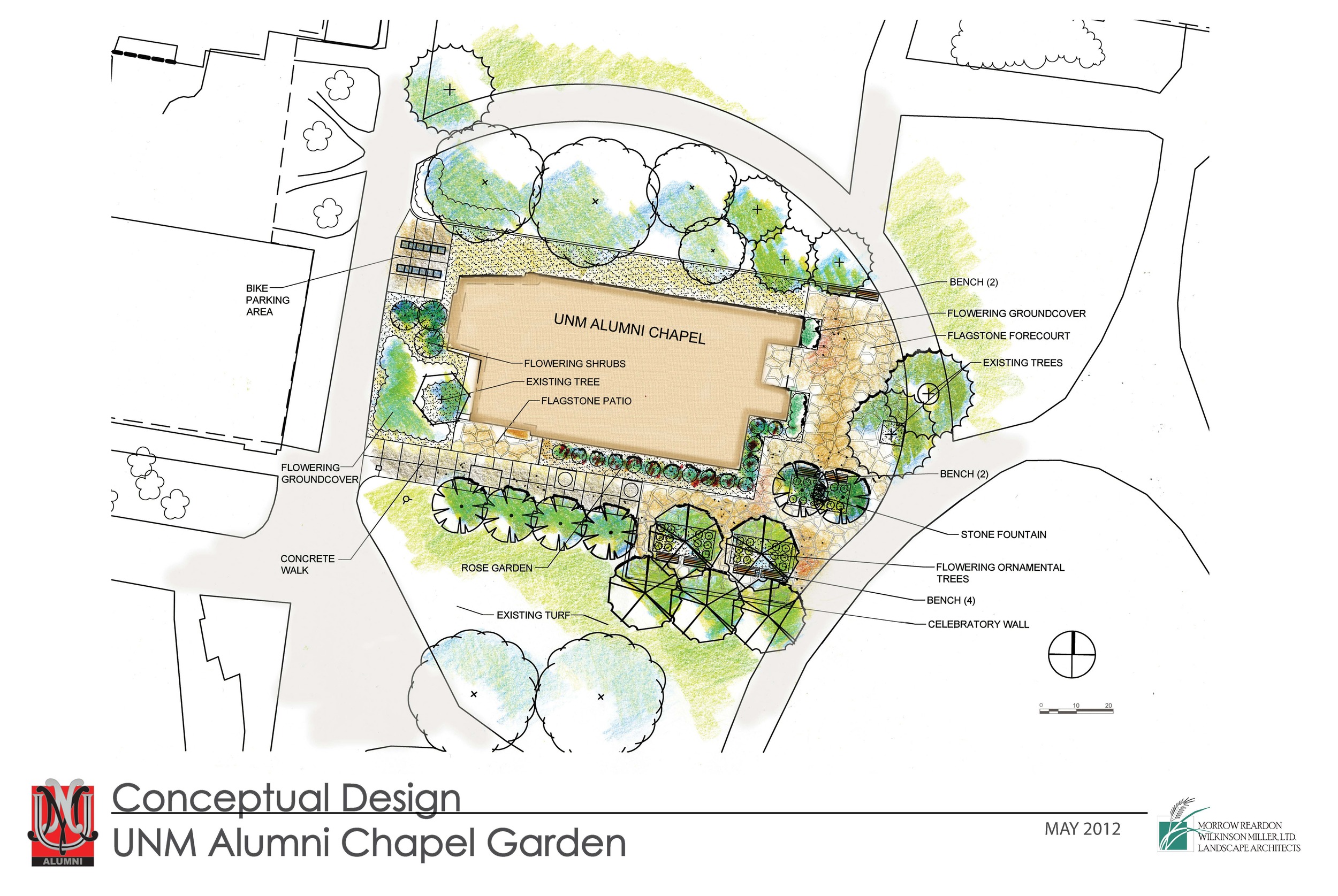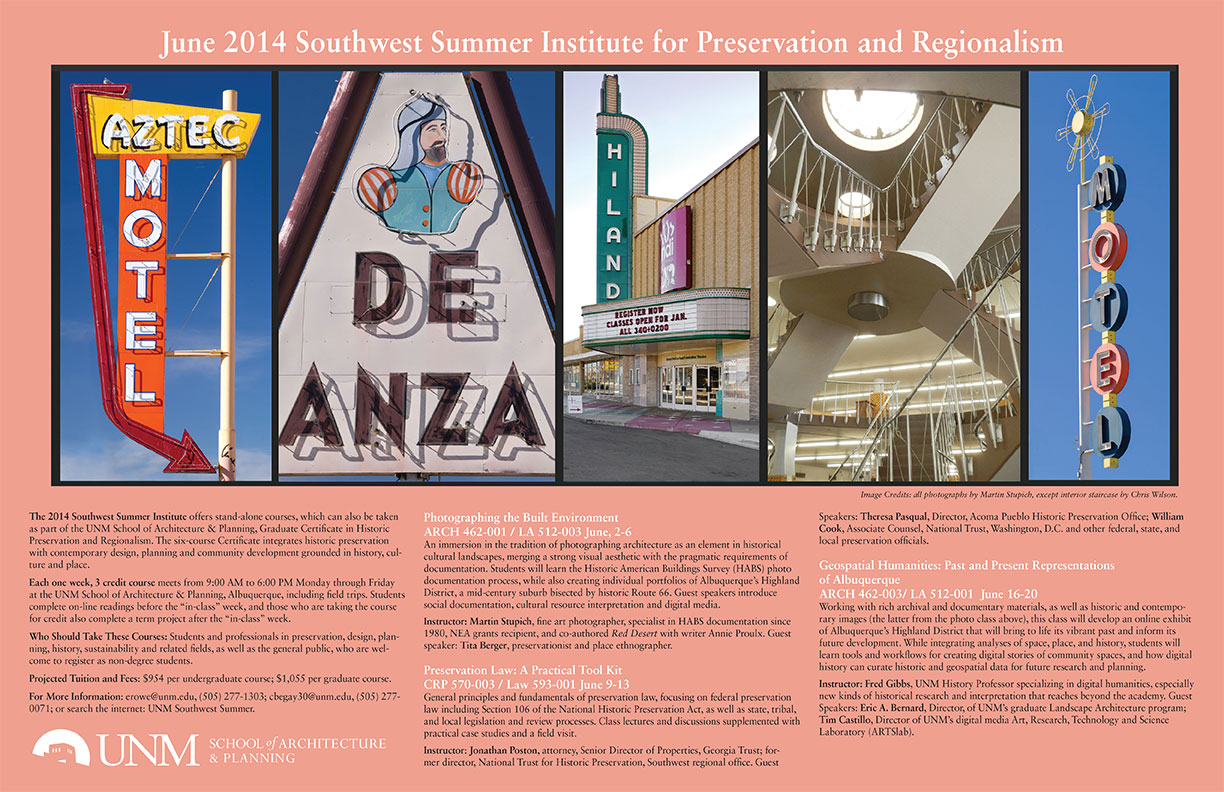Project Spotlight - UNM Alumni Chapel
Landscape Architect: Morrow Reardon Wilkinson Miller, Ltd.
Albuquerque, New Mexico
Client: UNM Alumni Association
Construction Cost: $201,900.00
Completion Date: Spring 2013
Contractor: Westwind Landscape Construction
MRWM worked closely with the Alumni Association and University Landscape Architect on the renovation of the historic UNM Alumni Chapel. The landscape resets this striking piece of architecture in a culturally and historically appropriate context. The project consists of the redesign of the Chapel forecourt and the addition of a ‘celebratory wall’ and walkway. The celebratory wall is designed to display donors’ photographs of memorable events held at this important University landmark. The forecourt was expanded, creating much-needed flexible exterior gathering space and seating for chapel events. The landscape design is simple and elegant, and in keeping with the chapel’s traditional Franciscan Mission architectural style. Referencing traditional landscape features, the forecourt includes flagstone paving, a rose garden, a stone fountain, and a fruitless crabapple tree mini-orchard.
We'd love to highlight one of your projects in an upcoming newsletter! Contact us to share your work.
New Member Spotlight: Meet David Flores!
Landscape Architecture seems to be the perfect sport between two contrasting and competing identities. Nature and Man. The two inevitably collide. They meet on the ground, and in the dirt. It’s a battle ground. Landscape Architecture sets the rules of the game, moderates, reconciles the differences, and uses the energy between the two to turn the conflict into a thing of beauty and art. I do like life’s epic struggles.
I stumbled upon Landscape Architecture. It was vaguely introduced to me, though, through two classes I took as a Freshman and Sophomore at West Mesa High School called “Engineering Graphics” and “Architectural Drafting”. I took these classes because I couldn't sing or dance. I was familiar with residential building construction, having been raised with ten brothers and sisters and a family owned Heating and Cooling business. The business ran from our home. It was called, “Flores Sheet Metal”, which I mistakenly heard as a child “Sheep Metal”. Why not? We had sheep, from time to time. I had rarely seen anything beyond the standardized home design. It was a challenge to get a lot of traction in my class beyond a simplistic floor plan. What grabbed my attention was the “Plot Plan” which was in essence, a simple landscape planting plan. I spent more time developing this plan than the building structure. I was alone among my class mates in this respect. Perhaps it tugged at my rural valley roots. Getting up early, feeding various farm animals, cutting weeds, opening the irrigation ditch for the garden, trees, and vines were common chores as a youngster. After two years, I moved on to college prep classes, focusing on math and engineering. My two older brothers were also pursuing careers in engineering, so my dad saw engineering as a logical path. I was a goal oriented yet confused young boy. I resisted conformity. I still do, to some extent. Before country was cool, I was the only student in my high school to wear cowboy boots; at least for a year. Some social trends I still reject, to distinguish myself. Naturally, the expectation to be another engineer within the family was met with stubborn resistance. But what would I choose? What did I enjoy? Hunting and fishing, maybe? Our Math and Science Club was taking a field trip to the Engineering College at NMSU. Secretly, I had other motives for the trip. I wanted to see the Agriculture and Tourism College advertised in a brochure. I told no one, except my parents. In one visit, I was sold.
Las Cruces had palm trees! It was not too far for a nervous kid unprepared to leave home. Alas, the prospect of being the only kid in the family to go away to college would further the chance to distinguish myself. Then, I ran into my brutally honest brother, Paul. He posed a scenario to his new prospecting Wildlife Biologist brother; “What sort of life will you have if you get stuck out in the middle of nowhere? Alright, we love the mountains, but do you want to be a hermit? There are no girls out there!” I got mad. Then, I thought “Oh, well, he may have a point”. I was actually more receptive to his point of view than I was leading on. Something caught my attention during my trip to NMSU. I didn’t tell anyone at my school, except my parents. I shared with them this academic study that involved cultivated plants, trees, vines, weeds, insects, pesticides, chile research, and laboratories! All this seemed too good to be true. We planted. We stacked hay. My mom kept over 50 bee hives. Winemaking was something my dad began in early 1980’s, having over 100 vines take over the east garden area. Discussion of expanding this endeavor was a topic around the dinner table on many occasions. I thought, perhaps, I might be able to apply the rigors of science into something that I could relate to. This opportunity exists in a University just 3 hours away. I never really got too excited with the prospects of being an engineer. It didn't touch my soul.
After starting off strong and enthusiastic my Freshman year at NMSU, I found myself doubting again. My brother Paul asked me when I came home, “You know, I really don’t see many jobs in your major. All I see are landscape jobs”. Argh! I didn't own a farm. I didn't want to work in a greenhouse. Genetics, Pest Management, Weed Science, Soil Science – all these may have been too narrowly focused for a kid not ready to commit. I then found a class that offered an introduction to Site Design using a computer aided drafting program. I was having fun again, like high school, but with computers this time. I was concerned, though, about the prospects of this field of study. I was not dealing with large sites. Landscape companies still did their plans by hand. Landscape Architecture was waiting around the corner, but I was unaware. After various summer jobs with landscape companies and nurseries, I came back for my Senior year. I was worried; the landscape industry seemed too small, intense, and possibly unsuitable for this new graduate. I could have stayed working in the Sheet Metal business – making more money, too. Did I waste my time? I was, of course, a “twenty nothing”. I decided to stay on for graduate work.
That summer, my advising professor gave me a reference to a local “Landscape Architect”. Joni Gutierrez worked for the City of Las Cruces, was locally grown, and was one of the most captivating personalities I've ever met. She was a graduate from the University of Arizona, which had this “Landscape Architecture” program. “I’ll be darned”, I thought, “There’s something else out there”. I worked on that new AutoCAD program for her, instead of hand drafting. I left Las Cruces to work in Albuquerque again. I had a new baby on the way. Months later, I received a call to interview for a position with the City of Las Cruces. I worked for the City of Las Cruces for almost three years, but when I visited Albuquerque, there was a clear difference between the budgets of these two cities. The Bio Park unveiled, and I was impressed. “Maybe someday”, I thought.
A mid level Project Coordinator position opened in the City of Albuquerque in 1998. I applied, interviewed, was hired, left Las Cruces on a Friday, and reported for work in Albuquerque that Monday. By Thursday, I regretted leaving my job in Las Cruces, were I burned hours of the day in deeply focused drafting. I was confused as to why I wouldn't be drafting. By a few months later, I finally learned my role as a Project Manager. I’ve been fortunate and blessed being involved in so many projects working with so many professionals in this community. I love serving this community. I love this profession. When my wife and I travel, I look for all the noteworthy parks: Central Park, Prospect Park, Washington Park, Golden Gate Park, Balboa Park, Franklin Park, Boston Common, Millennium Park, San Antonio Riverwalk, City Park, Audubon Park, to name a few. I was given full responsibility of our Division December of 2012. I addressed my team with a question and a challenge: What will be our legacy? The Open Space Program founders were brilliant in preserving land. Those who solidified the long term Joint-Use partnership with APS land for park purposes were prudent. Those who purchased large tracts of land to respond to a growing and more active population were bold. How will we respond to changing needs, trends, and demographics? Will we be able to maintain quality parks with depleting resources and environmental stresses accumulating? Will we see opportunities when they come, and have the influence to seize that day?
I hope someday this City will be able to publish and market something special and different within our park system. We have a battlefield waging outside, between Nature and Man. Many of those battles are on the grounds of the City of Albuquerque’s Parks, Trails, and Open Space System. I am, ever watchful, waiting for that next great move forward. Perhaps it is destiny that I’m in this position. My Registered Landscape Architect license number is 505, for goodness sake!
Contact David.
Thesis Spotlight - Remediating the Present to Rejuvenate the Past: Reclaiming the Albuquerque Rail Yards
By Kevin Amagai, Associate ASLA, UNM MLA, Spring '14
Problem:
The settlement of many large cities in the western United States erupted from an industrial core. Factories, plants, and rail yards create employment opportunities drawing an influx of people from across the nation. The cities continue to grow but when new opportunities arise, or if the industrial center shuts down, employees leave and what remains is the shell of what used to be. The abandonment of the industrial site leaves the soil contaminated and the neighborhood blighted. The result is that many major U.S. cities “have experienced wrenching plants downsizing and shutdowns, leaving underused or abandoned-and almost always contaminated-industrial sites.”
Industrial Heritage:
Similar to cultural heritage, industrial heritage responds to the history of the city and the involvement industry had in its development. In many cases, the remains of by tearing down historical monuments, the related history becomes lost. The history of the community creates a common language which the members of the community can understand. When preserving a landscape, the historic landscape is important, but preservation efforts should be a hinting at the past, not a literal translation. By doing so, the spirit of the place, the zeitgeist, can be achieved; reclaiming what the site may have been like as it flourished.
Phytoremediation:
Using the plant’s natural ability to detoxify or remove pollutants from the environment allows the existing site to heal without the need to replace contaminated soils. It is an extremely affordable solution, however, due to the fact that it is a relatively young science (starting in 1990), and requires a large amount of water, the science has not been thoroughly studied in the Southwest. There are seven techniques, or mechanisms, by which a plant can remediate soil. Each species of plant used for phytoremediation should be selected according to their root structure, the hardiness of the plant, the growth rate, ease of maintenance, and the ability to extract or degrade contaminants of toxic products.
Context:
Located directly south of downtown Albuquerque, the Barelas neighborhood is one of the oldest areas of the city. Originally a small agricultural community, the introduction of the rail system transformed Barelas into an industrial community. Local businesses and industries were dependent on the railroad and its ability to transport goods and services. At the height of activity, 4000-6000 cars traveled through the community daily.
Beginning in the mid 1950’s, Barelas began its long economic decline. The introduction of the diesel engine in locomotives allowed trains to travel ten times the distance before it needed repair. This allowed trains to bypass the Albuquerque Rail Yards. With the loss of the major revenue of engine repair, the Rail Yards were unable to stay in business.
Site:
The Rail Yards is a 27.3 acre complex with 21 buildings that remain since its operation. It is bordered by parcels owned by the Burlington Northern Santa Fe Railroad to the north and south, an active railway that runs parallel to the east, and 2nd Street to the west. The turntable located on the southern half of the site remains active and prevents any design intervention from occurring. Large portions of the soil are contaminated with lead and petroleum and will need to be addressed prior to long term exposure to humans.
Intervention:
Dividing the site into a series of spaces allows for variation in programs. It also addresses the need to remediate the existing soil by providing multiple methods to extract and/or degrade the contaminants. It also creates multiple nodes of connection that will help establish circulation throughout the entire site.
Albuquerque Rail Yards Design:
The primary goals for this design were to remediate the soils through natural methods as well as elevating the industrial heritage of the site. Using the existing structures as a backdrop, the design treats the site as an outdoor museum that provides the public with an educational tour that revisits the history of transportation and the involvement of the Rail Yards. The outdoor venue space presents an opportunity for music festivals, talent shows, and plays.
Key Features of the Design:
- A multi-phase design that allows for the quick and rapid degradation of contaminants at a shallow depth while allowing trees to establish to remediate at deeper depths.
- The reconstruction of the demolished Roundhouse as a trellis.
- Adaptation of existing buildings for commercial use.
- An outdoor venue for performances.
- An aerial path over the active railway to create a gateway to the neighboring community.
- Bike and pedestrian paths that extend past the limits of the site to connect to existing networks.
- A temporary sculptural art exhibit that showcases local artists.
Conclusion:
Redeveloping brownfield sites is critical in the growth of cities for various reasons: the proximity they have to the urban core, the economic opportunity they present, and the revitalization of adjacent communities. Natural methods of remediation, such as phytoremediation, require a longer timeframe than excavating contaminated soils, but it will fix the existing soil. Redeveloping brownfield sites will also rejuvenate the site’s industrial heritage and responds to the spirit of the place, a sense of the way the site used to be.
The implementation of the design for the Albuquerque Rail Yards depicts the future for the site. Industrial buildings and artifacts hidden in a lush canopy creates a sense of adventure and exploration as visitors walk through the site. Local musical performances display a variety of talent from community members. Business men and women nationwide attend conferences held in various shops on site. These visions provide opportunity for the future for both the Rail Yards and the Barelas neighborhood.
Works Cited:
Collaton, Elizabeth, and Charles Bartsch. 1996. “Industrial Site Reuse and Urban Redevelopment--An Overview.” Citiscape: A Journal of Policy Development and Research 2 (3): 17-61
Jackson, J.B. 1980. “The Necessity for Ruins and Other Topics.” 1st ed. Vol. 20. Amherst: University of Massachusetts Press.
Kirkwood, Niall. 2001. Manufactured Sites : Rethinking the Post-Industrial Landscape / Edited by Niall Kirkwood. London ; New York : Spon Press, 2001.
Contact Kevin.
Trustee's Report
By Chris Green, PLA, ASLA
Board of Trustees Mid-year Meeting, Advocacy Day
Your New Mexico contingent (Rob Loftis, Greg Miller, President-Elect Victor Trujillo, National Student Representative to the BOT Andrew Bernard, and myself) paid visits to the offices of Sen. Tom Udall, Sen. Martin Heinrich, and Rep. Michelle Lujan Grisham to discuss legislation primarily related to transportation infrastructure issues.
NMASLA Advocate Selfie
Safe Streets Act of 2014 (S.2004, H.R.2468) - Requires each state to have in effect within two years a law, or each state DOT and MPO an explicit policy statement, that requires all federally-funded transportation projects, with certain exceptions, to accommodate the safety and convenience of all users in accordance with certain complete streets principles. Sen. Heinrich is a co-sponsor of this legislation.
New Opportunities for Bicycle and Pedestrian Infrastructure Financing Act of 2014 (H.R.3978) - Authorizes the Secretary of Transportation (DOT) to establish a pilot program to make loans and loan guarantees to eligible entities to carry out bicycle and pedestrian infrastructure projects. The purposes of this Act are to (1) To promote investment in bicycling and walking infrastructure to create and connect transportation networks; (2) To improve access to employment, business districts, and transit in communities traditionally underserved by existing transportation systems by establishing additional opportunities for financing nonmotorized infrastructure projects; (3) To attract new investment to business districts and neighborhoods in low-income communities; and, (4) To leverage Federal funds and private investment in low-income communities and those traditionally underserved by existing transportation systems. This piece of legislation would require a $2 million minimum for projects, opposed to the $50 million minimum required by a normal TIFIA-funded project, which makes this funding more accessible for pedestrian/bicycle related projects .Rep. Ben Ray Lujan is a co-sponsor of this legislation.
ASLA is also urging Congress to pass a long-term transportation reauthorization bill that continues the Transportation Alternatives Program (TAP), including the Safe Routes to School and Recreational Trails programs. In June 2012, Congress passed and President Obama signed into law a new surface transportation law, MAP-21, which consolidated the three major bicycle, walking, and trails programs: Transportation Enhancements; Safe Routes to School (SRTS); and Recreational Trails (RTP) programs, into one single program-TAP. MAP-21 will expire on September 30, 2014, requiring Congress to pass another surface transportation law soon.
More information on these issues is available on the ASLA website under the ADVOCATE tab. Check it out and stay informed on issues that are important to our profession.
Dues Increase
The Finance and Investments and Member Services Committees recommended, and the Board of Trustees approved a dues increase as follows: $10 increase (to $345) effective January 1, 2015 for Full, International and Affiliate Members; $5 increase (to $55/$270/$55 respectively) effective January 1, 2015 for Emerging Professionals, Associate Members and Student Members; and $10 increase (to $355) effective January 1, 2016 for Full, International and Affiliate Members. The primary reasons for this increase are to adjust for inflation; to maintain the revenue from membership dues at a consistent percentage of our operating budget, which keeps us within an acceptable range to maintain the Society’s tax-exempt status; and, although the Society has weathered the economic storm, program costs are rising, and this increase will help to avoid any cuts in the program services provided to members. They key message in this discussion was that we need to continue to grow our membership, so please encourage your peers who may not be a member to join up and see what ASLA can do for them.
Society Finances
Regarding the Society’s finances, first quarter cash requirements tend to be low, so ASLA has a strong cash position. Additionally, the stock market is doing well, which helps ASLA’s long-term reserve position. Generally, most areas of the business at the end of the first quarter are tracking below the budget. The most significant observation for the quarter is that ASLA is making contributions to the long-term reserve. Based on ASLA’s strong cash position a $120,000 contribution was made from the short-term reserve to the long-term reserve as authorized by the Finance & Investment Committee. As authorized by the BOT in Boston, the ASLA building mortgage will be paid off on June 27, 2014, using the funds liquidated from the long-term reserve in 2013. When combined, the cash, money market account, short-term reserve and long-term reserve total $8.3 million, which represents approximately 72 percent of the Society’s annual operating expenses. It is our goal to eventually increase those figures to be 100 percent of annual operating expenses.
Executive Committee Presentations
Candidate presentations were made to the BOT for the positions of VP for Finance, Membership, and Professional Practice. After voting, your new VP’s are Jeffrey Townshend, ASLA (Finance), Keith Wilson, ASLA (Membership), and Hunter Beckham, ASLA (Professional Practice). Presentations were also made by the two President-elect candidates; Chad Danos, FASLA, and Shawn Kelly, FASLA. I hope you all take the opportunity to vote for the candidate of your choice.
Strategic Objectives
Among the BOT’s most important responsibilities are setting the Society’s goals and objectives, establishing policy and direction, and monitoring the program and budget in the context of the strategic plan. Each year, at the midyear meeting, the BOT reviews the relative importance of ASLA’s strategic objectives and evaluates program effectiveness against the objectives they support. This year, the BOT was tasked with evaluating and revising, if needed, the strategic objectives. This was done in the form of a SWOT (Strengths, Weaknesses, Opportunities, Threats) analysis, to identify priority issues related to: nexus with ASLA strategic objectives; National ASLA’s ability to make an impact; member relevance; and timeliness or urgency. While it was a very lively and interesting discussion, the information is too broad to present here, so if you’d like to see some of the specifics please feel free to contact me and I’m happy to review it with you over a cocktail.
Please feel free to contact me if you’d like additional information on these topics or any other ASLA issues.
Three UNM Summer Courses you should know about...
JUNE, 2-6 Photographing the Built Environment
JUNE 9-13 Preservation Law: A Practical Tool Kit
JUNE 16-20 Geospatial Humanities
Each one week, 3 credit course meets from 9:00 AM to 6:00 PM Monday through Friday at the UNM School of Architecture & Planning, Albuquerque, including field trips. Students complete on-line readings before the "in-class" week, and those who are taking the course for credit also complete a term project after the “in-class” week. Courses are open to the general public, who are welcome to register as non-degree students. Registration Information: Beth Rowe, erowe@unm.edu, (505) 277-1303.
JUNE, 2-6, Photographing the Built Environment, ARCH 462-001 / LA 512-003
An immersion in the tradition of photographing architecture as an element in historical cultural landscapes, merging a strong visual aesthetic with the pragmatic requirements of documentation. Students will learn the Historic American Buildings Survey (HABS) photo documentation process, while also creating individual portfolios of Albuquerque's Highland District, a mid-century suburb bisected by historic Route 66. Guest speakers introduce social documentation, cultural resource interpretation and digital media. Instructor: Martin Stupich, fine art photographer, specialist in HABS documentation since 1980, NEA grants recipient, and co-authored Red Desert with writer Annie Proulx. Guest speaker: Tita Berger, preservationist and place ethnographer.
JUNE 9-13, Preservation Law: A Practical Tool Kit, CRP 570-003 / Law 593-001
General principles and fundamentals of preservation law, focusing on federal preservation law including Section 106 of the National Historic Preservation Act, as well as state, tribal, and local legislation and review processes. Class lectures and discussions supplemented with practical case studies and a field visit. Instructor: Jonathan Poston, attorney, Senior Director of Properties, Georgia Trust; former director, National Trust for Historic Preservation, Southwest regional office. Guest Speakers: Theresa Pasqual, Director, Acoma Pueblo Historic Preservation Office; William Cook, Associate Counsel, National Trust, Washington, D.C. and other federal, state, and local preservation officials.
JUNE 16-20, Geospatial Humanities: Past and Present Representations of Albuquerque. ARCH 462-003/ LA 512-001
Working with rich archival and documentary materials, as well as historic and contemporary images (the latter from the photo class above), this class will develop an online exhibit of Albuquerque's Highland District that will bring to life its vibrant past and inform its future development. While integrating analyses of space, place, and history, students will learn tools and workflows for creating digital stories of community spaces, and how digital history can curate historic and geospatial data for future research and planning. Instructor: Fred Gibbs, UNM History Professor specializing in digital humanities, especially new kinds of historical research and interpretation that reaches beyond the academy. Guest Speakers: Eric A. Bernard, Director, of UNM’s graduate Landscape Architecture program; Tim Castillo, Director of UNM’s digital media Art, Research, Technology and Science Laboratory (ARTSlab).
Who Should Take These Courses: Students and professionals in preservation, design, planning, history, sustainability and related fields, as well as the general public, who are welcome to register as non-degree students. Projected Tuition and Fees: $954 per undergraduate course; $1,055 per graduate course.
Worm Your Way to a Healthy Garden
by Amos Oak Arber, ASLA - Assistant Curator, ABQ Botanic Garden
And check out an appearance by Amos on KASA Fox:
ARCHI-TRIVIA: Trivia Night Out
By, Jitka Dekojova, Associate ASLA
Can you name three female architects practicing in New Mexico? Can you name one? Do you know in what city the xeriscape concept started? Can you name a famous civil engineer? Do you know where the largest living roof in the state of New Mexico is? And do you know what happens when architects ask questions about soils?
A toast from trivia judge, Roger Schluntz.
The first mixed professionals ARCHI-TRIVIA was held on Wednesday 2/26 at the Gold Street Café. Six teams competed for cash prizes while enjoying refreshments provided by sponsors NMASLA and AIA. The mood was competitive, joyous, and relaxed – almost festive. The teams consisted of mostly architects, with a mix of professionals and students, a few civil engineers, and one landscape architect. There were 5 rounds of questions ranging from local historic topics, famous quotes, and site designs, to design references in pop culture. Answers were judged by UNM architecture professor extraordinaire Roger Schluntz. Heated debate broke out (resolved: gravel is not a soil type) and were able to be settled without insults or fisticuffs. Most importantly, everyone had fun – and learned few things. “We can drink and work – that’s what we do”, said one competitor summarizing the event. The evening was made possible through the help of several people, especially Tina Reames of Cherry/See/Reames Architects.
The Paper Space Cadets discuss a winning strategy.
Mixed professionals trivia night will be a regular event from now on, offering a chance for some fun competition and to make connections with other professionals. Let’s gear up for the next round!
Interested in participating in the next Trivia Night Out? Contact Jitka: jdekojova@hulc.com
February 11th, 2014 Declared Complete Streets Day in New Mexico
The New Mexico Complete Streets Leadership Team declared February 11th, 2014 Complete Streets Day in New Mexico at the 2014 legislative session in Santa Fe. A coalition of health and transportation professionals, many of whom are members of the NM Complete Streets Leadership Team, provided statements about the importance of planning, designing and building our roadways for all users and users of all ages and abilities. The speakers presented their testimony that day and were on hand at the Roundhouse to distribute information on Complete Streets in support of Complete Streets policies for New Mexicans. Speakers included Dan Majewski, UrbanABQ; Savina Garcia, Wilson & Company; Amy Bell, New Mexico Chapter of the American Society of Landscape Architects; Sharon Hausam Ph.D., AICP, Pueblo of Laguna; Richard Kozol, M.D.; and Senator Cisco McSorely.
For more information on the NM Complete Streets Leadership Team, you can visit their Facebook page: https://www.facebook.com/CompleteStreetsInNewMexico.
Project Spotlight - Field Geometry: A house in Corrales
By Judith Wong, PLA, ASLA
This design incorporates chance and change as an integral part of its aesthetic. The recurrence of individual forms and the repeating lines of the furrows create a backdrop against which variations are displayed. Cycles of growth are enriched by the fluid patters and sounds of wind movement. View a slideshow of the project here.
Results of State Advocacy Priorities Survey Published
New Mexico ASLA members were surveyed regarding advocacy issues in our state. View the results here.
The Root of the Problem: How Commercial Arborists Play a Vital Role in the Inspection Process
Click here to read this fascinating article by James Urban, FASLA. (Reprinted, with permission from the Society of Commercial Arboriculture.)
Surroundings Studio on PBS!
NMASLA member Kenneth Francis of Surroundings Studio is interviewed on PBS in Austin, Texas. Check out the video here, or find a link on their Facebook page.
2014 Sustainable Santa Fe Award Nominations Sought
The City of Santa Fe is seeking nominations for the 2014 Sustainable Santa Fe Awards to recognize model sustainability projects that are helping Santa Fe reduce it ecological footprint, mitigate carbon emissions and build resilience in the face of climate change, in accordance with the Sustainable Santa Fe Plan. These annual awards have been given since 2009. Awards are limited to projects or programs with significant events that occurred during the 2013 calendar year or ongoing programs that haven’t yet been recognized.
Sustainable Santa Fe Annual Award recipients will be recognized during an annual awards reception in association with Earth Day which will be promoted on the Sustainable Santa Fe Facebook page (like us to follow), in the Green Fire Times, and local media outlets.
Award categories include:
- Community Outreach
- Environmental Advocacy
- Environmental Justice
- Food System
- Climate Adaptation – Water
- Climate Adaptation – Ecosystem
- Renewable Energy / Energy Efficiency
- Affordable Green Building / Building Systems
- Green Economic Development
- Low Carbon Transportation
- Waste Reduction
- Green Journalism
- Youth Led
- Other
Nominations will be accepted until March 15, 2014. Nominations can be made online. A link to the nomination form can be found at the City’s website or at the website of any of the co-sponsors of the event including Earth Care, the Santa Fe Green Chamber, and the Green Fire Times. Separate nominations must be made for each project but you may nominate as many different projects as you wish.
New Member Spotlight: Meet Kelly Van Den Berg, Associate ASLA
I’ve spent most of my life on rivers. For 15 years I have worked as a river guide, river ranger and artist on rivers all over the Southwest. During this time, I have been watching and learning about the way the water flows, how the rocks were formed and who the people were that lived along those rivers before me. I teach the people who come on these trips about geology, plants, history and water politics.
I have noticed changes in these rivers. Some changes occur naturally each season after flooding with the shifting of sandy beaches and new channels carving their way through floodplains. But overall, I have noticed other changes. These desert rivers are acquiring more and more exotic vegetation with less diversity. They don’t consistently carry as much water from season to season and floods are becoming more intense causing unbalanced erosion. And the trash… Our rivers are in trouble and I want to help them. After being exposed to the Yuma East Wetland Project along the Colorado River, I saw the power of landscape architecture to bring about change.
While studying Landscape Architecture at the University of Arizona in Tucson, I quickly realized that the decline of my rivers was not easily fixed, nor was the issue limited to the wilderness areas I had called home. These were watershed issues that often had to do with urbanization and our treatment of water resources. I realized most people don’t even know where their water comes from, where it goes and what happens to it along the way and often is taken for granted and wasted.
As a landscape designer, I am motivated by issues of watershed health and rehabilitation, both in urban areas and in wilderness. I believe that in every design, we need to be thinking not only of form and color but more importantly, diversity of life and habitat value as our natural areas become urbanized. I am guided by ecological processes and believe it is important to incorporate public education about the issues we face and the solutions we come up with in our designs. I am also an avid fan of material and water reuse and challenge myself to incorporate reuse whenever possible.
After my partner and I decided we wanted to live in New Mexico, we started the process of trying to make it happen a couple of years ago. I have been fortunate enough to make it to several NMASLA events in the past couple of years in which I have met many welcoming professionals. In July, I started working as a landscape designer for Sites Southwest. I am constantly amazed at how much I learn everyday and how little I still know. I have been fortunate to be able to work on a variety of project types and find there is never a dull moment or project I don’t get excited about.
As I adjust to my new job, I look forward to continuing my education and hope to get LEED or perhaps one day SITES certified. In the future, I also look forward to getting more involved in community level water harvesting and promoting for change in New Mexico water policy.






